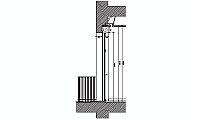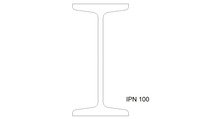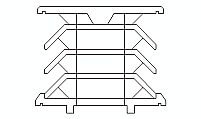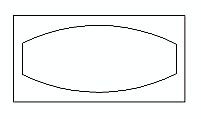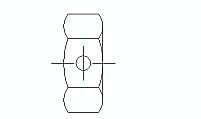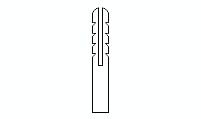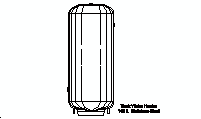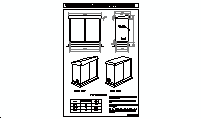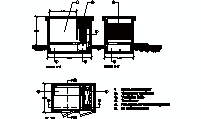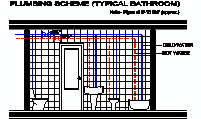CAD Blocks categories
 3D models
3D models home furniture
home furniture sanitary ware - bathrooms
sanitary ware - bathrooms professional equipment
professional equipment doors and windows
doors and windows people and animals
people and animals plants and trees
plants and trees vehicles - transports
vehicles - transports architectural details
architectural details mechanical - electrical
mechanical - electrical urban planning - civil works
urban planning - civil works safety health construction
safety health construction accessible design
accessible design drawing sheet
drawing sheet signals
signals construction machinery
construction machinery accessories and objects
accessories and objects maps and street maps
maps and street maps
Minimalist Steel or Aluminum Railing for CAD Projects

size: 8 kb
category: architectural details
related categories:
description: minimalist railing design with vertical steel or aluminum bars, securely anchored to the ceiling and the floor for enhanced stability and a clean aesthetic.
file extension: .dwg CAD - AutoCAD software
Detailed CAD Block of Minimalist Railing Design
Detailed Description of the Minimalist Steel / Aluminum Railing
This minimalist railing design features vertical bars crafted from either steel or aluminum, offering durability and a clean, modern aesthetic. The railing includes four stabilizing bars anchored securely to the ceiling and floor, ensuring both structural integrity and visual simplicity. The vertical bars are evenly spaced to achieve a sleek appearance, making it ideal for balconies, staircases, and terraces in residential and commercial settings.
Alternative materials such as stainless steel or powder-coated aluminum may be used to enhance the railing's resistance to weathering and corrosion. This design's straightforward geometry makes it highly adaptable to various architectural styles, from contemporary to industrial, ensuring a seamless fit with its surroundings.
Dimensions and U.S. Safety Standards for Railings
According to the International Residential Code (IRC) and the International Building Code (IBC) in the United States, railings must meet specific safety requirements. For vertical bars, the spacing should not exceed 4 inches (10.16 cm) to prevent accidents, particularly for young children. This guideline ensures adequate protection while maintaining an open design.
The minimum height for railings is specified as 36 inches (91.44 cm) for residential applications and 42 inches (106.68 cm) for commercial settings. These measurements are designed to provide sufficient protection against falls, ensuring compliance with safety standards in various architectural contexts.
Installation and Construction Tips
- How is this railing installed?
- The railing is installed by anchoring the vertical stabilizing bars to the ceiling and floor using heavy-duty brackets or embedded bolts. Proper alignment tools like laser levels ensure that the bars are evenly spaced and securely fastened for maximum stability and aesthetic uniformity.
- What materials are commonly used?
- Steel and aluminum are the primary materials for this design. Steel offers exceptional strength and is often coated to resist rust, while aluminum provides a lightweight yet durable alternative, ideal for easier installation and low maintenance.
- Can it be customized?
- Yes, customization options include altering the height, bar spacing, or surface finishes. Powder coatings in various colors can be applied to match specific design preferences. Adding decorative elements like top rail caps can also enhance the visual appeal.
- How do you maintain this railing?
- Regular cleaning with mild soap and water keeps the railing looking pristine. Aluminum railings may require occasional polishing to maintain their sheen, while steel railings should be inspected for any signs of rust and treated with protective coatings as needed.
- What tools are required for installation?
- Basic tools include drills, anchors, a level, and measuring tape. For steel railings, welding equipment may also be necessary. Proper safety gear, such as gloves and goggles, is essential during installation.
Advantages of Minimalist Steel / Aluminum Railings
Minimalist railings offer a perfect blend of simplicity and functionality. Their sleek vertical bars create an open and airy appearance, making them an excellent choice for modern architectural designs. The use of steel or aluminum ensures long-lasting durability while maintaining a lightweight structure.
Compared to ornate or bulky railing designs, minimalist railings are easier to install and require less maintenance. Their clean lines complement a wide range of interior and exterior styles, enhancing the aesthetic appeal of any space while ensuring safety and compliance with building codes.
History and Evolution of Minimalist Railing Designs
Minimalist railings emerged as part of the modernist architectural movement in the early 20th century, emphasizing clean lines and functional design. This approach rejected ornate styles in favor of simplicity and efficiency, leading to the widespread adoption of minimalist designs in both residential and commercial projects.
Over time, advancements in materials and manufacturing techniques allowed for greater customization and durability. Today, minimalist railings are a staple in contemporary architecture, combining aesthetics with practicality. Their ability to adapt to various styles and settings ensures their continued popularity in modern construction.



